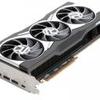Introduction
Radeon RX 6900 XT Review
Are you ready? Hey, are you ready for this? Yes, the lyrics (Another One Bites The Dust - Queen) from that song fit even better when you place it in a king and queen fashion. We review the king of the new Radeon RX 6x00 lineup from AMD. Everything about this product already has been said and stated; however, reviews have been lacking as AMD decided for a letter launch for this 6900 XT 16GB GDDR6 card towards today. The Radeon RX 6900 XT 16GB GDDR6 graphics card is the mac daddy of this trilogy; it has the full 80 CUs (compute units) enabled. Multiply that with 64 shader processors per unit, and your math ends up at 5120 shading/stream processors based on the new RDNS2 architecture, paired with that new L3 cache to help ou that 256-bit wise memory bus used for the 16 GB of GDDR6 memory.
Man, that a year it has been, everything came to a halt with the COVID-19 pandemic. And then, in Q4, everything that has been delayed got announced and released. These are an exhausting time for everybody in this industry. Q4 was here, and AMD presented its RDNA2 based technology. In the world of graphics technology, a new dynamic was added, Raytracing. Or, I should say hybrid DirectX Raytracing (DX-R). NVIDIA was pioneering two years ago with their RTX 2000 series already, AMD made the call to delay that for the original Navi GPU. As the graphics landscape changed somewhere done the line, so this the roadmap for AMD change. Microsoft and Sony consoles embedded with AMD technology revealed that Raytracing was going to be supported. And that did set the trend for the desktop graphics card we see announced. The current triplet of AMD 6800/6900 graphic cards are all based on the very same GPOU, Big Navi. They all hold the same GPU, just binned and somewhat 'weakened' to create a lineup. The GPUs are fabricated on an optimized 7nm node derived from TSMC. The cards are PCIe 4.0 interface compatible. For raytracing, the number of hardware-accelerated Raytracing cores is set up in a 1:1 creation towards the CU count, so that's 80 for the 6900 XT. Today we put the flagship Radeon Radeon RX 6900 XT to the test, a product that will cost you 999 USD; and for comparison, the RX 6800 XT costs 649 USD, the Radeon RX 6800 costs 579 USD with performance levels matching the completion RTX 3070 running up-to that RTX 3090. It does that by numerous architectural improvements, but sure, increasing transistor real-estate comes into play as the shader processor count has nearly doubled up over last generational products. The TDP listed is 300 watts. This fully enabled Big Navi based chip has a whopping 26.8 billion transistors. The card clocks in at a 2250 GHz boost and 2015 MHz game clock.
Radeon RX 6900 XT
The 6900 XT, which we review in this article, receives 80 activated CUs multiplied by 64 shader units is 5120 shading processors. This card gets 16 GB of GDDR6 memory based on a 256-bit memory bus, not to confuse the new GDDR6X memory NVIDIAusesg for RTX 3080 and 3090. So that means 512 GB/s of memory bandwidth. The TDP listed is at 300 watts for this product. The 2250 GHz boost clock is high. Much like its two siblings, the card has that new 128 MB 'infinity cache' (we'll call it L3 cache). The card is to take on NVIDIA's finest (currently), the GeForce RTX 3090. This graphics card will cost you a sweet sum of 999 USD, which is a third cheaper than that GeForce RTX 3090.
| Desktop | ||||||||
| GPU | Stream Processors | RT Cores | Max Boost GPU clock (MHz) | RAM type | RAM volume (GB) | RAM bandwidth (GB/s) | RAM width | TDP (watts) |
| Radeon RX 6900 XT | 5120 | 80 | 2250 | GDDR6 | 16 | 512 | 256-bit | 300 |
| Radeon RX 6800 XT | 4608 | 72 | 2250 | GDDR6 | 16 | 512 | 256-bit | 300 |
| Radeon RX 6800 | 3840 | 60 | 2105 | GDDR6 | 16 | 512 | 256-bit | 250 |
| Radeon RX 5700 XT | 2560 | 1605 | GDDR6 | 8 | 448 | 256-bit | 225 | |
| Radeon RX 5700 | 2304 | 1465 | GDDR6 | 8 | 448 | 256-bit | 180 | |
| Radeon VII | 3840 | 1400 | HBM2 | 16 | 1024 | 4096-bit | 300 | |
| Radeon RX Vega 64 | 4096 | 1247 | HBM2 | 8 | 484 | 2048-bit | 295 | |
| Radeon RX Vega 56 | 3584 | 1156 | HBM2 | 8 | 410 | 2048-bit | 210 | |
| Radeon RX 590 | 2304 | 1469 | GDDR5 | 8GB | 256 | 256-bit | 185 |
All three cards released by AMD and their board partners will receive GDDR6 memory, 16 GB of them. Again that's for all three cards. So that means a 256-bit wide memory bus. However, AMD has got a few tricks up their sleeves architecture wise, as they added a big phat whopper of an L3 cache into the GPU. RDNA2 based graphics processors are DirectX Ultimate compatible, which is a naming placeholder for extra feature levels such as DirectX Raytracing (DXR), Variable Rate Shading (VRS), Mesh Shaders, and Sampler Feedback. But we have a lot to talk about and show you, next page, please.

